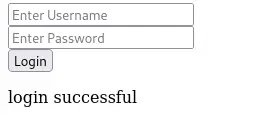How to Perform HTTP Authentication Using PHP Curl
-
Introduction to
php-curl -
Installation of the
php-curlLibrary in Ubuntu - Perform the Basic HTTP Authentication From HTML Form
-
Perform the Basic HTTP Authentication Using
cURL

This tutorial demonstrates how to perform HTTP authentication using the PHP cURL in Ubuntu.
Introduction to php-curl
cURL (Client URL) is a command-line utility that sends or receives data and files. It uses the URL syntax and supports protocols like FTP, FTPS, DICT, HTTP, HTTPS, etc.
The cURL library is available in PHP, called php-curl. We can use this library to communicate with servers by sending HTTP requests in PHP.
We can perform various tasks like setting cookies, using proxies, passing data over SSL connections and even authentication using php-curl.
Let’s look at the basic php-curl functions.
-
curl_init()- It initializes acURLsession. -
curl_close()- It closes acURLsession. -
curl_setopt(handle, option, value)- It sets option for thecURLsession. Here,handleis the value returned bycurl_init().The
optionparameter can have a wide value of options. You can find the list of options here.It is used according to the need. The
valueparameter has the value for the option. -
curl_exec()- It executes the predefinedcURLsession.
Installation of the php-curl Library in Ubuntu
Before performing the authentication, we must verify whether php-curl is installed in our system. We can do it with the following command.
php -m
The command lists the compiled PHP modules. If you can locate curl in the list, it means the php-curl is installed.
You can also verify its installation by checking the output of the phpinfo() function. If installed, a table for curl will appear in the output.
If php-curl is not installed, you can install it via the following command.
sudo apt-get install php-curl
After the installation, open the php.ini file and locate the line below.
;extension=curl
Uncomment the above line as below.
extension=curl
The final step is to restart the server with either of these commands.
sudo systemctl start apache2
sudo /etc/init.d/apache2 start
Perform the Basic HTTP Authentication From HTML Form
First, we will perform a basic authentication using only the HTTP POST method. We will create an HTML login form that accepts username and password.
We will check the user input with a set of predefined login credentials. Next, we will perform the HTTP authentication with cURL methods.
For example, create a directory curl in the /var/www/html and then create a file login.php. In the PHP file, create a login form using HTML.
Write the name attributes as uname and pass for username and password, as shown in the example below.
Code Example:
<form action="login.php" method="post">
<input type="text" placeholder="Enter Username" name="uname" required><br>
<input type="password" placeholder="Enter Password" name="pass" required><br>
<button type="submit" >Login</button>
</form>
Next, open the PHP tag and use the isset() function to check whether the username and password equal user123 and password123. Use the if condition to display the message accordingly, as shown in the example below.
if(isset($_POST['uname'])&& isset($_POST['pass']))
if($_POST['uname']=='user123' && $_POST['pass']=='password123'){
echo "login successful";
}
else{
echo "login failed";
}
Now, open the file from the server and fill out the login credentials as follows.
username=user123
password=password123
Output:

You can check the HTTP request in the Network tab of the Inspect Element option, as shown below.

You can test the authentication by submitting the wrong credentials to the form, displaying the message login failed. The wrong credentials can also be seen from the Request tab, as in the picture above.
Perform the Basic HTTP Authentication Using cURL
We can perform HTTP authentication using the above-listed cURL methods. First, we must create a payload to send the HTTP request to the server.
For example, create a file post.php inside the curl directory. In the PHP file, create an array $data and store the correct login credentials, as shown below.
$data = array(
"uname" => "user123",
"pass" => "password123",
"form" => "submit"
);
Next, create a variable ch to store the cURL session. Assign the function curl_init() with the URL http://localhost/curl/login.php to ch.
After that, use the curl_setopt() function to set the various options for the cURL session. Set the CURLOPT_FOLLOWLOCATION, CURLOPT_POST and CURLOPT_RETURNTRANSFER to TRUE.
Supply the payload $data for the CURLOPT_POSTFIELDS option. For the CURLOPT_COOKIEJAR option, write the cookie filename cookie.txt.
You must create an empty cookie.txt file to store the cookie in the project directory.
http://localhost/curl/login.phpis the target URL where we send the request withcURL.- The option
CURLOPT_FOLLOWLOCATIONset toTRUEfollows any header location that is redirected byLocation: header(). - The option
CURLOPT_POSTset toTRUEinforms the session that it is aPOSTrequest to the server. - The option
CURLOPT_POSTFIELDSdefines the payload sent in the request. - The option
CURLOPT_COOKIEJARsaves the cookies to the filecookie.txtafter thecURLsession is closed. - The option
CURLOPT_RETURNTRANSFERset toTRUEreturns the response of thecurl_exec()instead of direct input.
Finally, write the function curl_exec() with ch as the parameter to execute the cURL session and close the session with curl_close(). At last, display the output curl_exec() function.
Code Example:
$ch = curl_init('http://localhost/curl/login.php');
curl_setopt($ch, CURLOPT_FOLLOWLOCATION, TRUE);
curl_setopt($ch, CURLOPT_POST, TRUE);
curl_setopt($ch, CURLOPT_POSTFIELDS, $data);
curl_setopt($ch, CURLOPT_COOKIEJAR, 'cookie.txt');
curl_setopt($ch, CURLOPT_RETURNTRANSFER, TRUE);
$result = curl_exec($ch);
curl_close($ch);
echo $result;
Then, run the post.php script. The following output is received as the credentials are correct in the payload.

The output will say login failed if we use the wrong credentials.
Thus, this tutorial demonstrated how to perform a basic cURL authentication in PHP.
Subodh is a proactive software engineer, specialized in fintech industry and a writer who loves to express his software development learnings and set of skills through blogs and articles.
LinkedIn